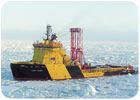
Swedish drilling vessel Vidar Viking led the Arctic Coring Expedition.
A group of ocean-drilling research scientists that has been exploring the Arctic Ocean subseafloor have released new findings.
The report, supported by Integrated Ocean Drilling Program (IODP) research operations, contains analyses of subseafloor sediment samples gathered from nearly 1,500 feet beneath the Arctic Ocean, near the North Pole. To recover the sediments that yielded the prehistoric climate records, the research team needed to manage three ice-breakers, one of which was equipped with a drill rig. The sediment records were recovered from the Lomonsov Ridge, in water more than 3,000 feet deep.
The IODP Arctic Coring Expedition (ACEX) scientists report their key findings in Nature:
- Evidence of ice in the Arctic Ocean was found much earlier than formerly believed - about 45 million years ago;
- At one time about 55 million years ago, Arctic temperatures rose into the 70s;
- At one time about 49 million years ago, the Arctic was green, with fresh surface water and large amounts of fern covering the water, at least in summer months.

Back on shore, splitting an ACEX core.
Moran's colleague, co-chief scientist Jan Backman, a professor at Stockholm University, Sweden, also recalls the challenging research conditions. “At times, the drill site was covered with ice [6 to 10 feet] thick. We encountered an ice flow of multi-year ice, harder and denser than ice from just one Arctic winter; it was like driving into a brick wall.” The upper sections (525 feet) of retrieved sediments indicate prevailing ice conditions during the last 14 to 16 million years.
A summary of the Arctic Coring Expedition is available online. The volume includes scientific and engineering results, drilling location maps, visual core descriptions and photographs of the cores. Visitwww.ecoed.org/exp/acex/vol302.
Report Abusive Comment